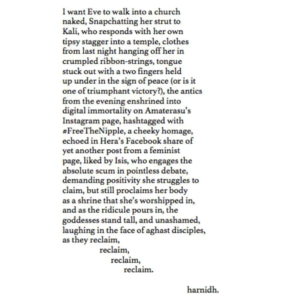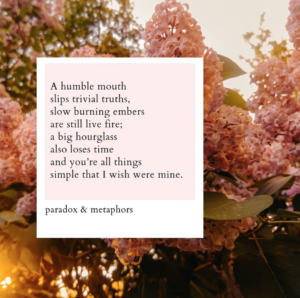Instagram brings back poetry from the dead

Since Rupi Kaur's success, there has been a flux of successful poets on Instagram. Left: Rupi Kaur; Right: Harnidh Kaur (Photo: Instagram)
Rupi Kaur, an Indian-Canadian who is the first of the “insta-poets” with 4.3 million followers, has been praised for being a voice of diversity in a poetry scene largely dominated by white, male authors. Her first collection, milk & honey, which reached the New York Times best seller list in 2016, has been translated into 40 languages and has sold 3.5 million copies. Last year, Kaur was invited to the famous American talk-show Jimmy Fallon, which she acknowledged as a rare achievement for any author.
Since Kaur’s massive success, there has been a flux of Indian poets who have found a large platform for their work on sites such as Instagram, winning coveted publishing deals and hundreds of thousands of followers. Influenced by Kaur’s free-verse, simplistic style, what makes this form of poetry so appealing to the masses is the focus on everyday issues that every young Indian can relate to, such as patriarchal constraints, teenage love and mental health. Nikita Gill is another Indian who has garnered a following of 627,000 followers on Instagram with her cathartic and brutally honest poems about depression and abuse.
Harnidh Kaur, a 26-year-old product marketing manager from Mumbai, published her first book, The Inability of Words, when she was just 20, and has a following of 37,000 people on Instagram (@harnidhk).
“Everything I write is a very real-time mirror of what’s happening in my life. I wrote about ’84 (anti-Sikh riots of 1984) at a time when I was contending with understanding my history. I write about friendship and personal growth now because especially in the middle of a pandemic and the way Covid-19 has shaped our world, I find it very important to catalogue the shifts and warps in my emotional growth because in a way, I have lost sense of time moving,” Kaur tells Media India Group.
Kaur has also explored hard-hitting themes like religion and politics. Her poem Pantheon, a re-imagining of feminist Indian goddesses, spurred a slew of hate mail and derogatory comments on social media.

Kaur’s ‘Pantheon’ received backlash on social media for its ‘controversial’ themes of feminism and religion
“I know people are very sensitive about religion, and they are particularly sensitive about a young woman talking about religion. A lot of patriarchal power derives from religion, so they know the moment young women realise that religion doesn’t serve them well, they are going to demand a shift,” she says.
In fact, hate is often directed at insta-poets by people who believe that social media writing hardly counts as good literature. Several critics have dismissed Rupi Kaur’s work, saying the obsession of her largely female and young fanbase is “more akin to that of a pop star rather than a traditional poet”.
However, Harnidh Kaur believes that social media poetry is a natural progression of the medium of poetry, able to distil the rhythm of the surrounding world into a cohesive format.
“What is traditional poetry? Is it sonnets, is it iambic pentameter? Traditional poetry is such a vague term and I think people use it to gatekeep the art form. People must have said the same thing to EE Cummings, Ezra Pound, to so many poets before us who decided to experiment with form and style,” says Kaur.
Like all art, poetry is subjective, and Kaur explains that what is ‘good or bad’ is eventually dependent on which pieces stand the test of time.
“It’s like when people say that only old Bollywood songs were great, but that’s not necessarily true, it’s just that songs today are a distilled version of that. So just because you are seeing an art form evolve in real time doesn’t mean it loses its value,” she adds.
Delhi-based Pratishtha Khattar, who posts poems for her 41,600 followers on her Instagram page @_paradoxandmetaphors_ , also disagrees with this notion and thinks that there is ample room for appreciating all styles of the art.
“Social media has opened up doors for a very wide audience. I think somebody who has not had the privilege of going to a fancy school or had that level of exposure in education, specifically in language and literature, may be unaware of the classics. But they do have Instagram. So, they can relate to people who are expressing the same issues but in simpler, or maybe less nuanced or layered ways,” Khattar tells Media India Group.

Khattar’s writings cover themes of seasonal love and exploring the beauty in diversity and coexisting perspectives in life (Photo: @_paradoxandmetaphors_)
This approachability has resulted in a new wave of poetry lovers among the youth. Rather than using what some may perceive as abstruse metaphors or complex terminology, what made Rupi Kaur so famous was her willingness to write about personal trauma and healing in a way that anyone could understand. It also serves as a springboard for improving literacy, as publishers say that increasing interest has propelled readers to buy the works of more classic and contemporary poets.
However, this accessibility has become a double-edged sword. In the beginning of her social media fame, Khattar enjoyed connecting with strangers through her writing.
“It felt like there were people for whom whatever you were writing was making sense, which really inspired me. Instagram has definitely changed shape and form considerably since then and become very commercialised. But when it works, there is a fair share of your audience that are loyal to you and stick around and really connect to you, so that keeps me going,” says Khattar.
Being so open on social media also invites a flood of criticism that was not seen as much with print publishing. Despite consistent advice to do so, Kaur has refused to take Pantheon down, not wanting to be dishonest about her personal politics. She explains that hate is a part and parcel of existing on social media, but that should not stop writers from speaking their truth. To illuminate this, she cites the concept of the “death of the author,” a concept in literary criticism that emphasises the importance of a reader’s interpretation over the author’s intended meaning.
“The problem with social media is that the author is not dead. There has always been a distance between the writer and the reader, which has now eroded very rapidly,” explains Kaur.
Despite the downsides, Instagram has helped boost the careers of many aspiring poets who never thought it possible to make a living from writing. Kaur’s new non-fiction book is set to be released by Harper Collins in 2021.
“Although writing is not my main career, I got my current job through social media, so the audience definitely helps. The more followers you have, the bigger your podium is. Over the years the community that has developed around me has been very helpful and influential,” she says.









